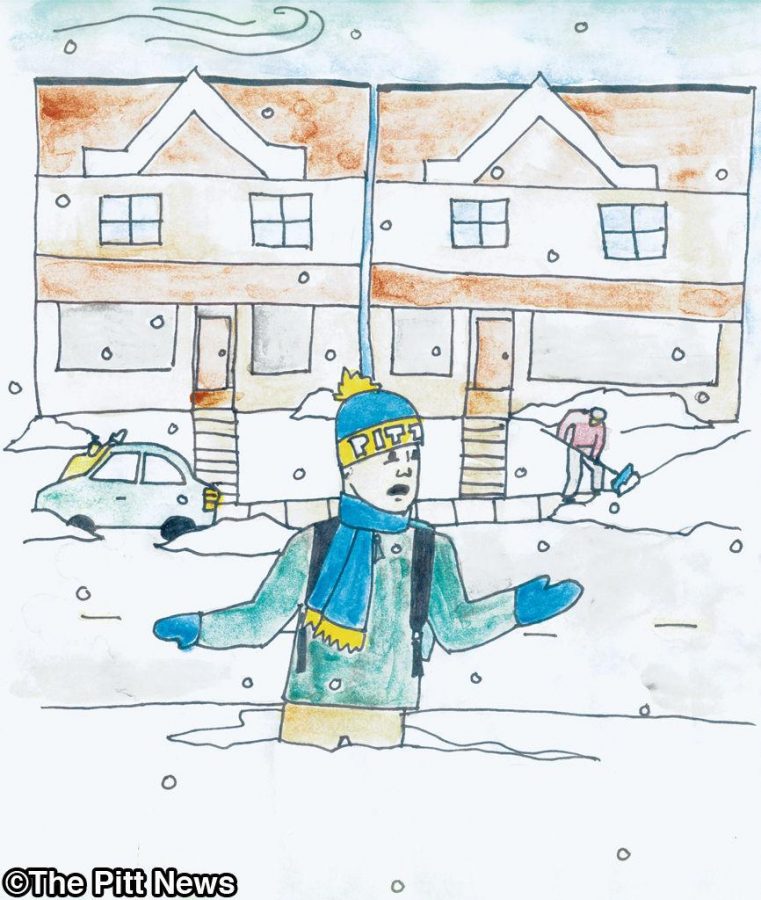Salt Savior: Students dread cold, University prepared
January 5, 2015
For students like Ellen Ross, living in deep South Oakland during last year’s “polar vortex” meant long underwear — and lots of it.
“I did stay in a lot more instead of going to hang with people or party, because I just didn’t want to go back outside,” said Ross, a junior neuroscience major who’s gearing up for another winter in Oakland.
Other Pitt students can commiserate with Ross’ difficulties of trudging to, from and around campus in wintry mixes. During the last year’s polar vortex, above average amounts of snow and freezing temperatures hit the Northeast.
Last winter’s freezing conditions resulted from a high-pressure system that pushed a large pocket of cold air farther south from its usual position, in the polar region, into the northern United States. This created the “polar vortex.”
Dennis Bowman, meteorologist for KDKA-TV Pittsburgh, said the season finished with 63.4 inches of snow, which is 22 inches above normal.
“Most of the snow accumulation was to the tune of 1-3 inch jobs. Snow fell on a total of 85 days during the winter, which contributed to the misery people experienced,” Bowman said.
Because of University policy, students have become accustomed to braving freezing cold temperatures and making their way to campus from all directions.
Pitt’s Policy on Extreme Weather Conditions, last updated in 2002, states, “Only by authorization of the Chancellor shall the University be officially closed.” Because of the services Pitt provides, the school remains open in “all but the most extreme circumstances.” These include food services like dining halls and kiosks.
The University last closed during a blizzard in 2007, according to University spokesperson John Fedele. “For the most part, we hear very few complaints about non-cancellation,” Fedele said in an email. “Most of our students are adults and are aware that their jobs, etc., won’t close down for most inclement weather either once they’ve graduated.”
Last year’s polar vortex, however, was not the worst storm season Pittsburgh has endured in recent years.
According to Bowman, who has worked in Pittsburgh since 1984, the “Snowmageddon” storm of 2010, which brought more than 20 inches of snow, “shut down the entire area and sent us galloping to a season total of 77.4 inches — third place on the all-time list for snow in Pittsburgh.”
During this storm, Allegheny County declared a state of emergency, and the National Guard was sent to help with the overwhelming amounts of snow blanketing western Pennsylvania. Point Park University and Carnegie Mellon were both closed for three days, while Pitt canceled only Saturday classes.
It’s unlikely that Chancellor Gallagher will break precedent, according to Ken Service, vice chancellor for communications.
Service said Gallagher, facing his first winter in his new position, could not “second guess decisions that were made by others a year ago about conditions and circumstances of which he has no direct knowledge.”
Mike Gable, president of the City of Pittsburgh Department of Public Works, said it takes an organized effort to keep the streets safe during extreme weather conditions. For instance, last year’s storms demanded an “additional 20,000 tons of material to salt the roads,” he said.
Fedele said the vast majority of Pitt’s students live either on campus or in close proximity to campus.
“It is only under the worst conditions that classes get canceled,” Fedele said.
But there’s good news for students at Pitt not looking forward to spending another winter frozen to the sidewalks.
Bowman predicts that due to the presence of a weak El Niño in the Pacific Basin, this winter will be “slightly above average on temperature and slightly below average on snowfall.”
Regardless, the Department of Public Works is ready to handle whatever Mother Nature brings — there is an ample amount of materials at the ready, with domes filled to capacity with salt, and a full staff working around the clock.
“It’s just a matter of flicking the switch,” Gable said. “We can’t time the storm. Everyone expects immediacy, but it’s just about getting that window of opportunity.”
For the University, cancellations result from similar spontaneity.
“There are so many variables when it comes to weather that it is really not possible to address hypothetical weather situations in advance,” Service said.
Even though 18,256 Pitt undergrads are from Pennsylvania, according to the University’s 2014 fact book, some are not used to cold winters.
“I’m not used to layering all of my clothes and feeling like the Michelin Man, but it’s the only way I can keep warm,” freshman Adelle Hamilton, a California native, said.
To prepare for another northeast winter, then, commuter students — who may have the most difficult time getting to and from campus in the snow — should make sure they have snow tires and are “making good decisions and taking the most well-traveled roads,” Gable said.
According to Ross, who said she was accustomed to harsh conditions, a pair of leggings or thermal wear under every outfit, sturdy boots and ear warmers are must-haves while making the frigid trek to campus.
While Hamilton will begrudge the white stuff on class days, she still plans to let her hair down under her ski cap for a bit of winter fun.
“I would love to take advantage of the snow by snowboarding,” Hamilton said. “I absolutely love it even though I’m not the greatest at it. I would even love to try sledding as it is something that I have never done before.”






